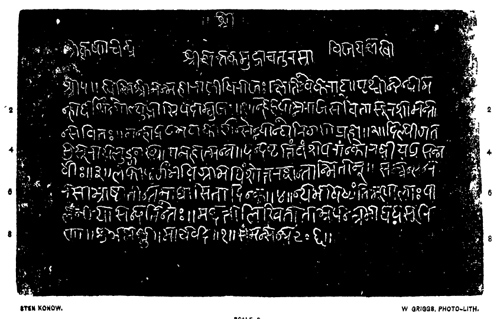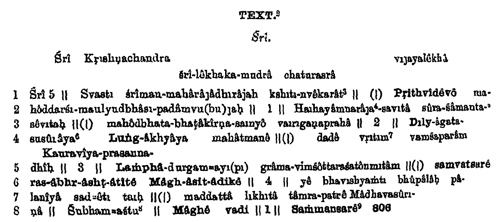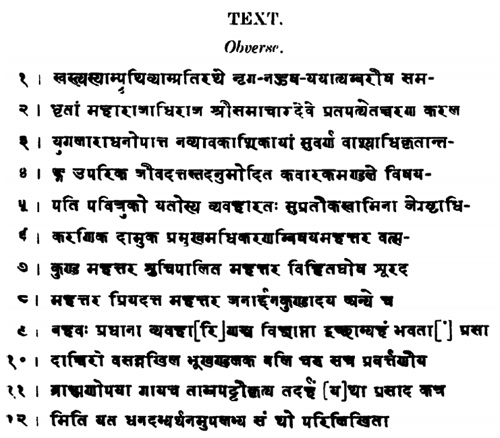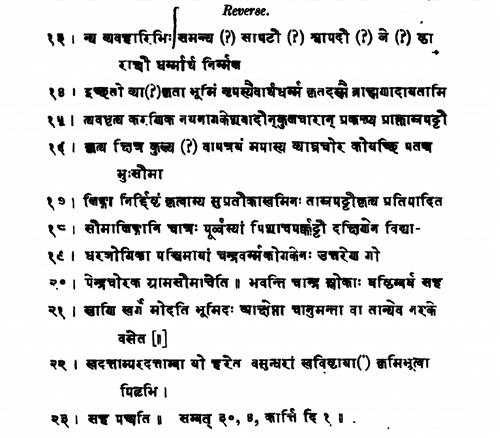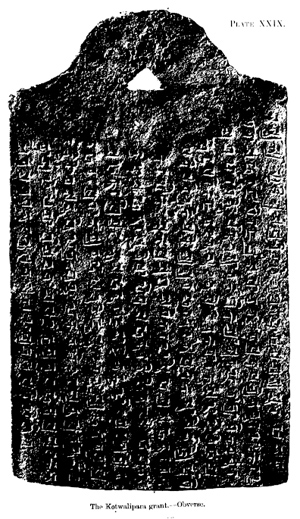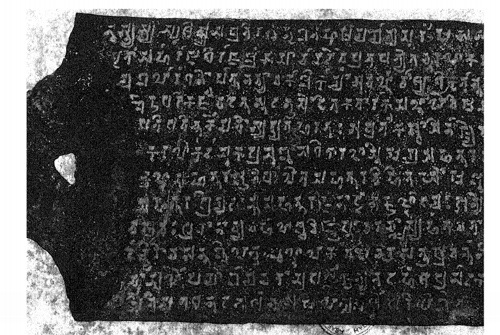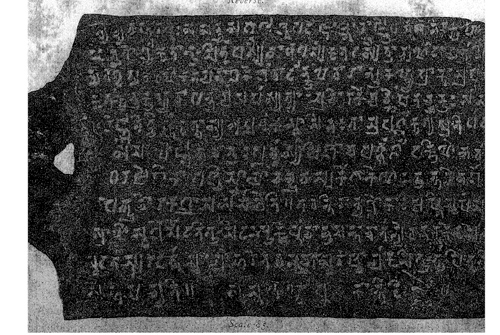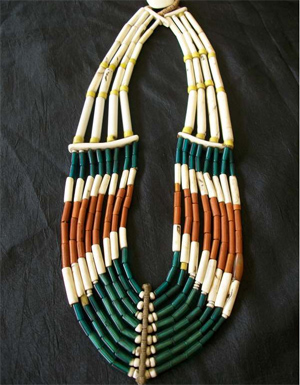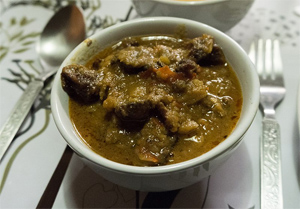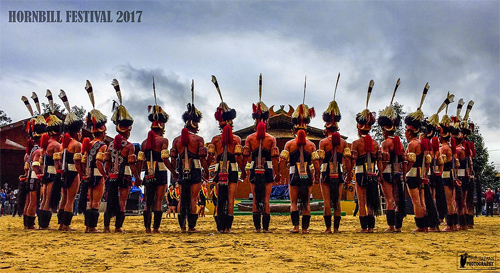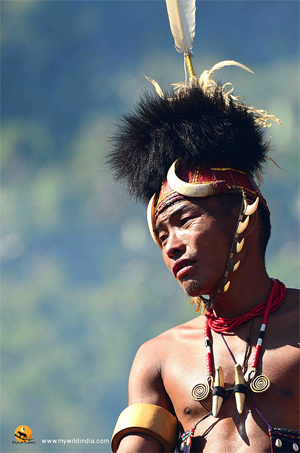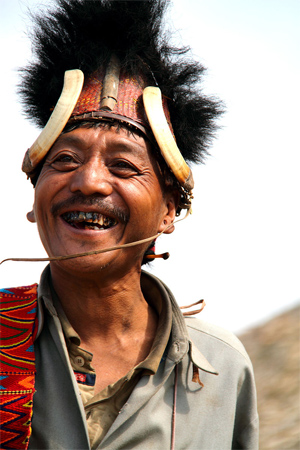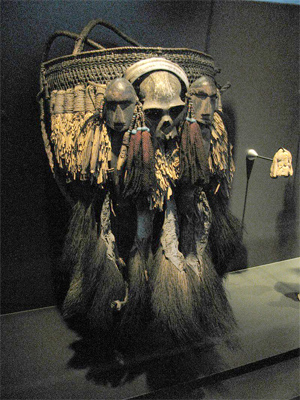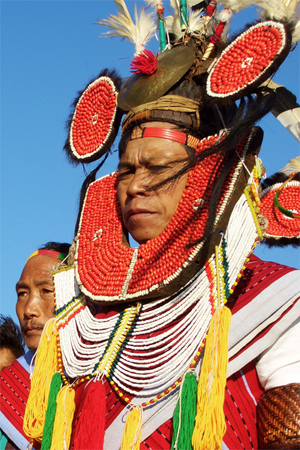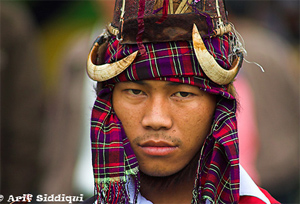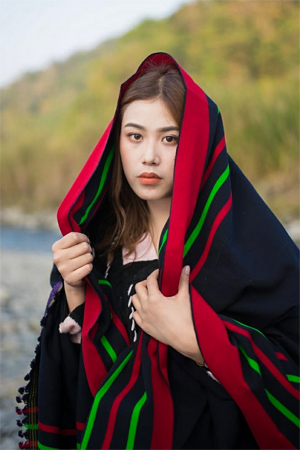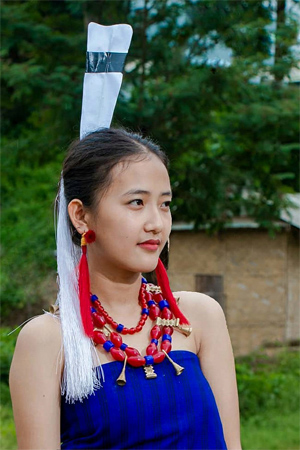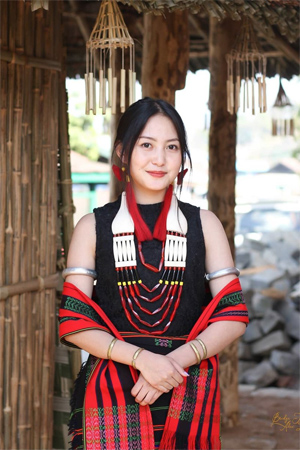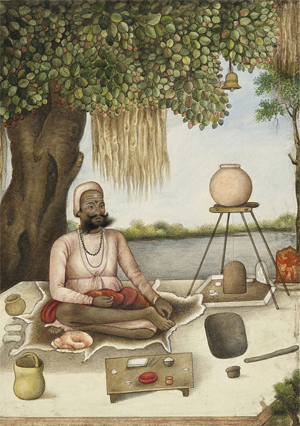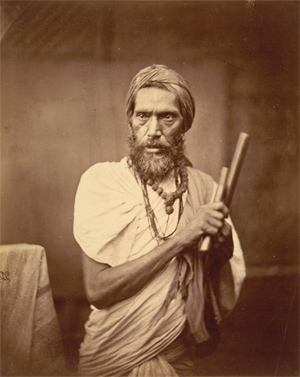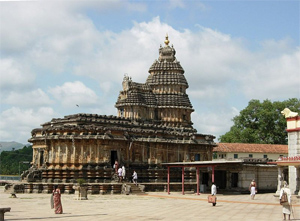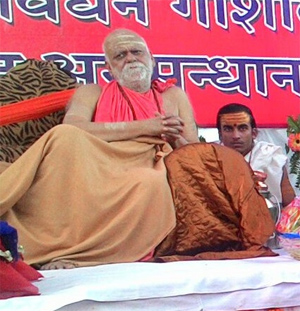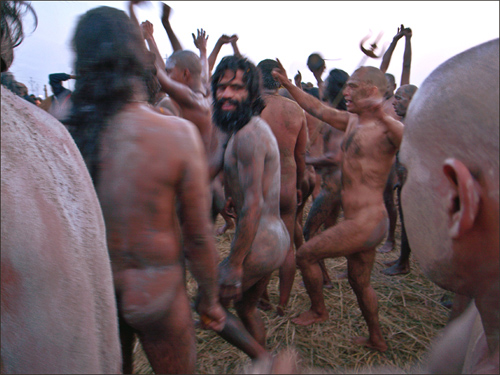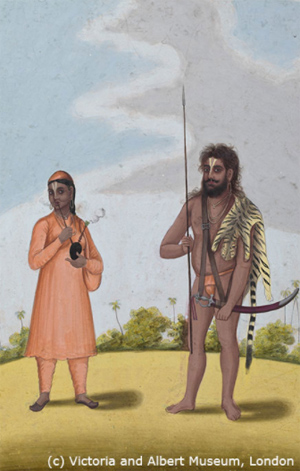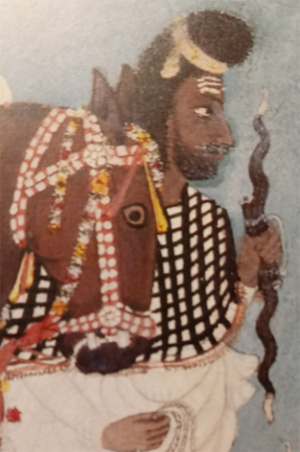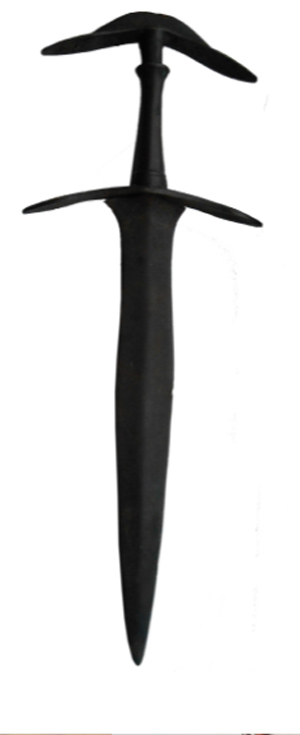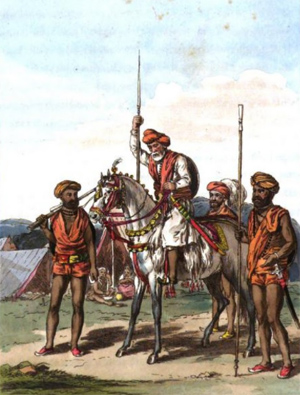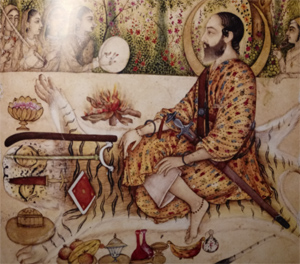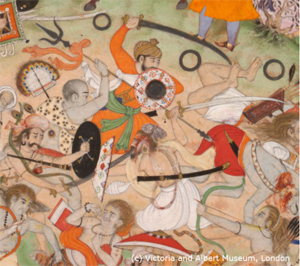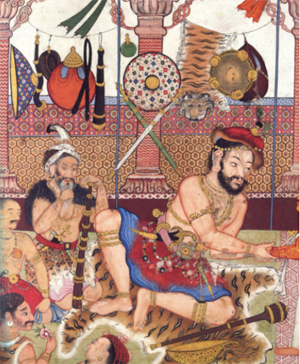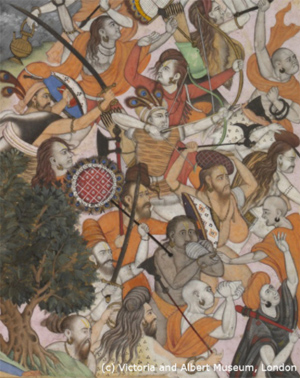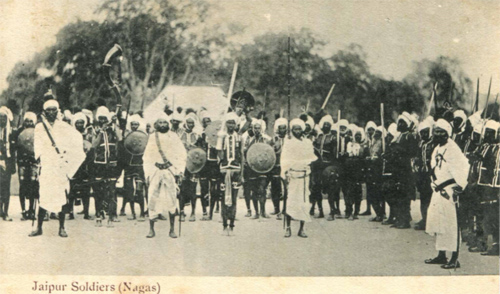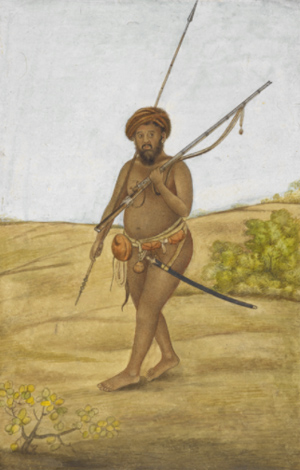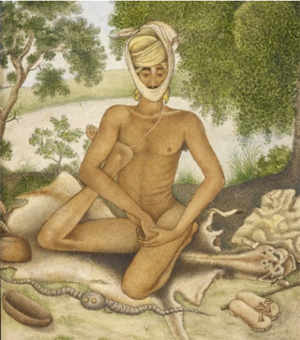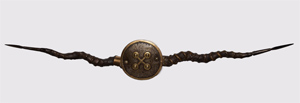Part 2 of 2
NOTES ON THE TRANSLATION.The mandala or province was Varaka in all the grants, and in addition to what has been said about Varendra in my article (p. 209), I may mention that Varendra was sometimes regarded as a part of Gauda-desa, for at the end of the description of the Purana-sarvasva MSS., numbered 143-4 in Aufrecht’s Bodleian Catalogue, a notice of its author is inserted which hbegins thus (p. 87) – Gaude Srividite Varendra-visaye, etc.
The capital of the province was New Avakasika as mentioned in that article (p. 22), and it is this grant which makes it clear, because the references to it in grants B and C leave uncertain what is meant by the term. At this time Jivadatta was the Uparika and ruler of the province and resided in New Avakasika, being a successor of the Uparika Nagadeva mentioned in grants B and C, for I agree with Babu R.D. Banerji (as will be shown later) in placing this grant later than the three others. He conducted a special branch of the administration, for he is called “the antaranga appointed over the suvarna-vothya in New Avakasika.” Antar-anga means “an inner member” and appears to denote a member of the inner council of the king. Suvarna-vothya seems to me, not a place because it was in New Avakasika, but some branch of the administration, as will be seen on comparing the corresponding passages in grants B and C. In both of those the Uparika Nagadeva had the office of “chief warden of the gate,” an din C he had been also appointed principal minister of trade (pp. 201, 205). Suvarna means gold, but vothya is not Sanskrit and must be some Prakrit or indigenous term Sanskritized. I cannot explain it, and can only suggest that it may mean something like ‘exchequer,’ and, if so, that the Uparika had charge of the Revenues or Finances.
Within the Varaka province were a number of visayas or districts, and Pavitruka was the lord or governor (pati) of the district in which this grant was made, as Jajava was in grant A (p. 195). It appears that under him the local administration continued to be, as in grants B and C, conducted by a Board of officials, in which the chief was the oldest official named Damuka.
The mahattaras were the local leading men, as explained in my article (p. 213), and this title with the word vara added, that is mahattaravara, is I conjecture the term from which has been derived the word matabbar or matabar, the title now given in Chittagong and East Bengal to the headmen of a village (p. 213, note). The expression which I read tentatively as svarada in I. 7 seems to imply a distinction from the word visaya in I. 6. The latter word is prefixed to the three mahattaras Vatsakunda, Sucipalita and Vihitaghosa, while svarada (?) is prefixed to the mahattaras Priyadatta and Janardanakunda. If one may venture a conjecture on this apparent distinction, it may be suggested that perhaps there were two classes of leading men, visaya-mahattaras and svarada (?) – mahattaras, the latter having a more local status than the former.
This copper-plate was found, as stated by Mr. Stapleton in his Prefatory note to Babu R.D. Banerji’s article, in the mauza of Ghagrahati, which adjoins Pinjuri on the south-west and borders on the river Ghagar, in the south-west corner of the Faridpur district. Some interesting inferences may be drawn by studying the local allusions in this grant with the aid of the Revenue Survey map of this region (on the scale of one inch to a mile).
The names of most significance are Vyaghra-coraka and Gopendra-coraka. The word coraka in them is an interesting one. It is clearly not Sanskrit, for the Sanskrit word coraka means only “a thief; a kind of plant; a kind of perfume”; and none of those meanings are appropriate here. There can be no doubt that it is the Sanskritized form of the common Bengali word [x], which is well known in its Anglicized form ‘char’ or ‘chur,’ any ‘alluvial formation thrown up in or at the side of a river-bed.’ Such chars are common in all rivers of any importance, and vary in size and character from a mere spit of unproductive sand o an extensive deposit of rich and fertile soil. The rivers of Bengal have always carried down large quantities of silt, and have always shifted their beds, the silt being deposited and forming chars wherever the current is slack. These chars are so important a feature of the riverine tracts that they must have had a name from the earliest times, and there can be no doubt that in coraka we have the Sanskrit form of the then vernacular word for ‘char.’ Chars, if of considerable size, are named, and the two names mentioned in this inscription are such as might be given at the present day, namely, “the Tiger’s char” (in Bengali [x] or [x]) and “Gopendra’s char.” This “Tiger’s char” was a large one, because a previous grant of three “kulya-sowing” areas of cultivated land had been made out of it, and by this grant the remainder was given to Supratika-svamin. In the article on the other grants the meaning of a “kulya-sowing area” has been discussed, and reasons have been adduced for estimating it at about an acre or three standards bighas (pp. 214-6). Hence the “Tiger’s char” was more than thrice that size and presumably contained a good deal more than nine bighas. A char of this size could only be formed in a rather large river; hence this char and Gopendra’s char were on the side of a rather large river, which corresponded therefore to the modern Ghagar. The map shows no trace at present that the Ghagar was connected northwards with the Ganges, yet it may have been so in early times, because the configuration of the Ghagar and the other water-ways near it favours this view, and it is well-known that river-beds have been completely silted up and obliterated.
Samtha or Santha is not a Sanskrit word, and can only, it seems, be the name of the place where this grant was made. It is stated the land was given by the vyavaharins or men of business who (as I read the passage) belonged to Santha. This word vyavaharin deserves notice, for nothing is said about villagers, and it suggests that Santa was not an ordinary agricultural village, but was rather a business place. As the chars were alongside it, it was evidently in close proximity to the river Ghagar. Hence it seems a fair inference, that Santa was a trading centre for ships and boats, and that the vyavaharins were the local merchants. I do not find any name resembling Santa in the map, but, as this copper-plate was found in Ghagrahati, one may reasonably presume it was found in its original site and that Ghagrahati is the modern name of the old Sana. This is supported by some further considerations; hence it appears that this grant should property be called the Ghagrahati grant.
Ghagrahati means “the village (or locality) of the hat (mart) on the Ghagar,” and proves that there was once a hat or mart at this place, though it has apparently long ceased to exist; and the fact, that the village took its name from the hat and not the hat from the village, shows that a trading mart was first founded here on the Ghagar, and that the village grew up from it. This accords well with the predominance assigned to the vyavaharins in this grant. A mart so situated was well placed as a trade centre for all the south west portion of the (Faridpur) district. It was connected with the sea by the fine water-way in the R. Madhumati and the Haringhata estuary, and the small ships of those days could have reached it readily. Such ships penetrated further inland for they are referred to in grant A (I. 24-5, and p. 198, note).
The existing hats are situated more northward. The present Ghagarhat, “the hat on the Ghagar,” is some three miles to the north; and there are besides Pinjuri-hat about a mile to the north-east, and Parkuna-hat about four miles to the north. The noteworthy point here is that “the hat on the Ghagar” has been shifted northwards. It was originally in Ghagrahati as the name testifies, and although this mauza still retains its name, the hat which give it its name has been moved to the north. What was the reason for the removal? I venture to suggest the following explanation.
The map shows that all the country adjoining Ghagrahati on the south and south-west is now bil or “marsh.” It is not likely that the ancient hat on the Ghagar would have been placed in proximity to a marsh, when excellent sites were available a little further northward. Elsewhere1 [In my “Revenue History of the Sundarbans” and in an article on the Sundarbans in the Calcutta Review in or about 1889. I cannot give more precise references as those publications are not beside me.] I have adduced reasons to show that there have been local subsidences of the land in the northern middle portion f the Sundarban region, sufficient to turn land that was of ordinarily elevation into marsh, and it is highly probable that some such subsidence took place in the southern tract of the Ghagar, because a large area south and south-west of Ghagrahati is now marsh. It may be inferred therefore that, when the hat was established in Ghagrahati, all the country around it was of good elevation, and that when the land subsided, the hat with the same name Ghagra-hat was moved northwards to a better situation, while the village around the old site remained with the name Ghagrahati. If this explanation is valid, one can well understand that this copper-plate might have been abandoned, where it has been found, as being no longer of any value; and that it was really a Ghagrahati grant.
Further, from the considerations put forward in my article on the other grants (p. 209) and from what is known of the course of Sundarban forest reclamation,2 [See my “Revenue History of the Sundarbans.”] it is very probable that the Sundarban forest could not have been very far from this spot at the time of this grant; and this is supported by the pointed reference to wild beasts in lines 13 and 14. Hence it seems that Santha could hardly have been a town, but was presumably something like what Morelganj, which is further south, was 60 or 70 years ago.
Character of the Grant.The place therefore being an outlying mart was not one where Brahmans of position would particularly choose to settle in. Supratika-svamin does not appear to have been a Brahman of position, for nothing is said about his lineage or attainments, such as we find in the other grants. In A the grantee Candra-svamin was of the lineage of Bharadvaja, was a Vajasaneya and studied the six Angas. In B and C the grantees Soma-svamin and Gomidatta-svamin were of the lineage of Kanva, were Vajasaneyas, are styled Lauhityas and are commended as virtuous. It appears from the tenor of this grant, that Supratika-svamin had come to this place and was willing, if he could get some land, to settle in it and perform religious rites. The matter was transacted between him and the vyavaharins who resided her. Nothing is said about the villagers taking any part in it. Information of the proposed transaction had to be given to the adhikarana and the mahattaras, as has been noticed in my article (p. 214), but it is stated clearly that it was the vyavaharins who accepted his proposal and gave him the land. The arrangement therefore was one entirely between him and them. There was no grantor who bought the land and bestowed it on a grantee as in the three other plates; but he asked for some land as a consideration for his undertaking as a Brahman to offer the bali, caru and sacrifices, and they accepted his proposal. It was no case of purchase, but a free gift by the vyavaharins on condition that he should perform priestly functions. The general terms used imply that he was to become priest to them generally, and that there was no other Brahman in the place. Here then we have an instance of the way in which Brahmans moved onwards and settled as priests in new places which had reached a position to need their services.
The arrangement was made with the cognizance of the adhikarana and in the presence of the mahattaras, and the seal of the adhikarana would have been affixed to this plate as it was to the other grants. The curved shape of the left-hand margin of the inscription in all the grants shows, that this plate was made to receive a round seal fastened on its front as the other grants still have, and that the triangular hole, which Babu R.D. Banerji comments on (p. 434), was made to enable the seal to be soldered through the hole on to the back of the plate. The fastening has decayed and the seal has been lost.
Supratika-svamin asked for a piece of waste land, and what was given him was the remainder of the “Tiger’s char.” As it was not bought from any one, but the vyavaharins gave it, it must have been the common property of the vyava-harins, if not of the whole village; and was therefore land somewhat similar to that in grant A, as explained in my article (p. 214). It was waste char and therefore land of recent formation; hence no reference was apparently necessary to the record-keeper as in the other grants (p. 213). As there was no purchase but the remainder of the char was given, it was unnecessary to measure the area as in those grants (p. 213). It was presumably covered with jungle in which tigers and other dangerous animals could lurk, for so much is implied by the citation of the verse, which contrasts the benefit that accrues to the king, when land is perfectly reclaimed, with what he loses when it is infested by wild beasts. It may also be inferred from that citation that the area was considerable, because the verse would not be significant, if the area was only a small patch insufficient to offer harbor to wild animals. It seems probable therefore that the remainder, which was given to Supratika-svamin, could hardly have been much less than what had been granted away previously.
Validity of the Grant.Babu R.D. Banerji pronounces the grant spurious and bases his decision on three grounds, (1) that the forger betrayed himself by introducing archaic and obsolete letters in the script, (2) that the grant does not follow the formula of a regular grant as found in the majority of copper-plate inscriptions, and (3) that its purport is irregular, obscure, ambiguous and in parts unintelligible. I do not see the cogency of these grounds to his conclusion, and for the following reasons. He reads the date as the year 34 and, assigning it to the Harsa Era, equates it with A.D. 640-1; and the gist of his criticisms on its script is to place its real period in about the last quarter of the 7th century (p. 432), that is, only some 40 or 50 years later than its professed date. If a forger wanted to make the grant appear to be only 40 or 50 years older than it really was, it was surely unnecessary for him to introduce obsolete letters and endanger his object by rendering its purport uncertain. This remark touches his first and third grounds, and the second will be considered later. See also postscript.
The true date however is the 14th regnal year of the monarch Samacaradeva. As nothing is known of him, his regnal year is no clue towards fixing the date of the grant. We must therefore estimate its period on other grounds; but before attempting that, I must first consider whether the three grounds mentioned above are really sound.
Babu R.D. Banerji says (p. 432), “the characters used in this copper-plate inscription were collected from alphabets in use in three different centuries,” namely, the alphabets of (1) the 3rd and the first half of the 4th century, A.D., (2) the last half of the 5th century and the first half of the 6th century of North-Eastern India, and (3) the 6th century which came into general use in North-Eastern India in the early part of the 7th century. Now it is well known that old habits persist in out-of-the-way places long after they have disappeared from more important and progressive places. Hence we ought to expect that a document executed in this outlying region should show older styles of writing than would be found in contemporaneous inscriptions at Bodh Gaya and Ganjam with which he compares this grant. An interesting illustration of this divergence is found in grant C. In the body of that deed the letter s is always written in its eastern form, but on the Government seal attached thereto it has the western form. The western variety therefore had been introduced at head-quarters while the eastern variety was in general use among the people.
I will now consider the remarks which Babu R.D. Banerji makes regarding various letters in proof of his conclusion stated above.
The first letter he discusses is h (p. 430). When uncompounded h is always (except in one instance) written here in early western Gupta form shown by Buhler in his Indische Paleographie, Table IV, cols. viii to xviii, which prevailed from about A.D. 500 to 675, and even earlier in the later Brahmi alphabet: see his Table III. The one exception is in sahasrani (II. 20-21), which Babu R.D. Banerji has overlooked, and there h has the early eastern form of a hook turned to the left. It has this form also when compounded with m in vrahmana (II. 11 and 14). The early western shape is used in the Bodh Gaya inscription of Mahanaman which is dated in A.D. 588-9 (FGI. p. 274), and is found in this Faridpur district even earlier, for it occurs in grant A which belongs to about the year 531. Babu R.D. Banerji says—“In a previous number of the Journal I have tried to establish that the Eastern variety of the early Gupta alphabet was dying out in the early decades of the fifth century” (pp. 430-1); but that proposition must be revised in the light of the three grants edited by me. In grant A of 531 A.D. both forms of h are used, the eastern 9 times and the western 6 times, and it appears they were used indifferently, because both are used in the same words maharaja (I. 2), anugraha (II. 18 and 19) and Himasena (II. 23 and 25), and both occur in line 4 and again in I. 8. There hm appears in the eastern form (I. 8). In grant B, the date of which is 567 at the latest, only the western form is used throughout, even in hm (II. 9 and 20). But in grant C, which is some 20 years later, the eastern form is sued throughout and the western form does not appear at all in the portions that are legible. Those grants show clearly that the two forms were in use side by side in this region during the 6th century, and the eastern form at least a century and a half later than he estimates, and that even then the western form had attained no ascendancy over the eastern. The fact then that in this grant the western form is sued generally and the eastern once uncompounded and twice in hm is in full agreement with the other grants, and is no indication of falsity but rather a local characteristic of genuineness.
The next letter he notices is long I (p. 431). I have discussed its shape partially above (p. 479), and may here point out that it tended to vary considerably. Its various forms in grant A may be seen on comparing (to give only salient instances) Sila (I. 24), °padaniya° (I. 22), kriya (I. 8), vikriya (I. 11), sri (I. 2), grhitva (I. 8) and kirtti (I. 14). The copy of grant B on plate II does not show all details quite clearly, yet the shapes of I may be noticed in sima (I. 21) sri (I. 2), parkkrati (I. 21) and vikriya° (I. 14). Grant C is so badly corroded on its obverse that there is not the same opportunity of scrutinizing details, yet the form of I may be seen in vikkritam (I. 20), sila and sima (I. 23), sima (II. 22-3) and pratita (I. 19). There was a tendency to reduce the size of the inner curl of this vowel sign, and in these last two words and in vikriya° (grant B, I. 14) it has practically degenerated into a dot connected with the outer curve. To separate the dot and the curve would be a natural modification, as we find in this grant; and here the I sign always consists of a dot or small stroke, and a curve on its right, except in Supratika (I. 17) where their position is reversed. The form of I then in this grant is no indication that it is spurious.
His third point relates to initial I (p. 431). This occurs only once, in icchami (I. 9); and his reading of icchato (I. 14) is untenable as explained above (p. 483). The I in icchami consists of two dots, one above the other, and a perpendicular stroke on their right. There is nothing suspicious in this form, because it is used in the same word in grant A (I. 7). It occurs in inscriptions of the fourth and fifth centuries (see Buhler’s Table IV, cols. I and v), and persisted later in this outlying region.
His fourth point (p. 431), in so far as it is definite, relates to m and the bipartite y. The m’s in this grant are like those in grants B and C and are not open to distrust. I have discussed the forms of y in my article (pp. 206-7), and the form which it has in this plate is always of the third and latest style which has been figured there. The instances here present three stages in its formation. In the earliest of these the left perpendicular reaches the bottom horizontal stroke, as shown in the second y of Yayati (I. 1), visaya (I. 4) and °yogaya (I. 11); and this shape constitutes a connecting link with the second form figured in my article. The second stage is exhibited in pascimayam (I. 19), and the third in ttrayam and yac (I. 16). Similar stages may be traced in grant C in the words Kasikayam (I. 3), vikkriya° (I. 17) and yo (I. 24). This grant is therefore closely like C as regards bipartite y, and differs from it in no longer using the earlier form figured by me as the second. It thus appears that as regards both m and y there is no ground for suspicion in this grant. He adds – “The bipartite ya looks ill side by side with sa, ja and ha (when it occurs alone) in which no acute angle can be traced”; but my scrutiny of this grant does not support this statement, and letters like these in shape are found in grant C. I need not dilate on this statement.
He deals next with the letter la (p. 431). Its form here is the later western shape, and it is also found in Grant B, where for instance we may compare laddha° (I. 3), kale (I. 4), Gopala (I. 5), etc. The earlier western shape is more prevalent in grant C, in which the left limb of l is not carried to the top of the line, as we see in kula (I. 18), sila (I. 19), nalena (I. 19), lingani (I. 21), etc.; yet even there l occurs once in Dhruvilaty (I. 22) like l in this grant. In grant A all the forms of l are used indifferently; thus the eastern form appears in labdha° (I. 2), kala (I. 5), labhah (I. 13), abhilasa (I. 14), samkalpabhi (I. 14) and sila (I. 24); the earlier western form in Kula (I. 4); and a shape nearly approaching the later western form in mandale (I. 3), likhita (I. 20) and lingani (I. 23). It thus appears that both the eastern and the western forms of l were in use in this region in 531 the date of grant A, and, though the former does not occur in grants B and C, yet it may have lingered on in this remote locality, so that its use in this grant is no certain ground for disparagement.
The sixth point (p. 431) concerns the letter da (that is, da) and has been discussed above (p. 478).
Seventhly, Babu R.D. Banerji refers (p. 432) to the word parkkatti (I. 18). He objects to the form of the pa as peculiar, and says, it “does not resemble the remaining ones, which are usually rectangular in form, seldom showing an acute angle.” This p however has the same shape as that in pravarttaniya (I. 10), nrpasya (I. 14) and pisaca (I. 18); and p in several cases varies from the rectangular shape, in prasada (I. 11), pari° (I. 12), Supratika and patti (I. 17) and pitrbhi (I. 22). He adds, “the earliest occurrence of this form of pa is to be found in inscriptions of the seventh and eighth centuries A.D.;” but the acute-angled shape is found in the Bodh Gaya inscription of Mahanaman of 588-9 (FGI. p. 274), and is figured as earlier by Buhler in his Table IV, col. ix. Most stress however is laid on the second aksara rkka, which he says “consists of two looped kas and a superscript ra;” but the upper k is not looped as shown in the plate published with his article, and only the second is looped. Precisely this form of doubled k is found in the Bodh Gaya inscription of 588-9; and therefore his remark that “this form of ka becomes fairly common from the last quarter of the seventh century A.D. and afterwards” (p. 432) needs modification. There is nothing objectionable therefore in the forms of pa and rkka in this grant.
I have now considered all his criticisms on the script in this grant, and have shown that the features which he distrusts are to be found in other almost contemporaneous inscriptions which are genuine; so that as regards the script there is nothing suspicious in this grant.
In stating his second ground for discrediting this grant he points out that it differs from the formula found in the majority of copper-plate inscriptions (p. 432). I need not examine the formula, because he refers to grants in which the donor is a royal person; whereas this grant is, as explained above (p. 491), not a royal grant but a grant by the businessmen of Santha of a part of the common land of their village. Hence that formula can have no application here, and the procedure was quite different. What the formalities on such occasions were has been discussed in my article (p. 214) and noticed above (p. 491), and the same procedure was observed in this grant as in the three others. Hence his strictures on its form (p. 433) are misplaced.
One important point must be kept in mind in construing ancient grants. It is a fact well known to all Revenue Officers, that, when gifts of land were made in old times, they might be granted either subject to the land-tax due to the sovereign, or exempt therefrom; that is, they might be (in modern Revenue language) either ‘revenue-payng’ or ‘revenue-free.’ It was no doubt to guard the royal revenues from being endangered that the parties to a grant were required to give notice to the Government. Neither the king nor his high officials could attend every small grant such as these were, and it would seem that the mahattaras attended as representatives of the local administration at the transaction.
Babu R.D. Banerji points out that grants might be forged, and cites an instance mentioned in the Madhuban Plate of Harsa (Epig. Ind. VII, 155). Certainl grants were sometimes forged, but the particulars and circumstances of that case and this grant are altogether different. In that case the Brahman, who held the kuta-sasana, claimed a whole village under it. What he did was obviously this. He did not dispossess the inhabitants and cultivators of the village (for he could not cultivate the lands himself and certainly did not depopulate it) and they remained, but he imposed himself upon them as lord of the village. All that he would have claimed from them was the various taxes and dues payable by them and, as they were bound to pay those, he would not have interfered with their life and ways more than the sovereign’s own officers who levied those demands, unless he exacted more. The position of the villagers therefore remained unaffected, and the person who suffered was the king, because the whole, or at least a part, of the revenue might have been intercepted by the false grantee. It was therefore for the king to annul the false grant, and not for the villagers to contest it.
The particulars and circumstances of this grant however were altogether different, as has been already explained. It is incredible that a poor Brahman of no position, who wanted only a parcel of waste land for his personal occupation, could have foisted himself into this village by forging a copper-plate grant for a piece of char land as having been given to him by the business-men of the village. If he attempted such a fraud, he would have set the whole village up in arms against himself, and his claim would have been instantly disproved by the inhabitants and the mahattaras. Further, such a deed, if forged forty or fifty years after its alleged date to support a claim to this piece of land, would have been wholly futile, because it would have been refuted by the fact, which every villager would have known, that he had not been in possession of the land during those years. In fact, this grant was a natural agreement between the people and the Brahman for their mutual benefit, and its very pettiness shews it cannot be spurious. Moreover it is expressly said that the cultivation of waste land increases the king’s revenue.
Babu R.D. Banerji’s third ground deals with the meaning of this grant. He says the wording “is very ambiguous” (p. 433), and “The contents of lines 12 and 13 are quite unintelligible. Here and there words of Sanskritic origin are to be found mixed up with what seems to be unintelligible gibberish” (pp. 433-4). I venture to think that my reading and translation redeem the grant from this condemnation, and render it not only clear and intelligible but also remarkably vivid in its local references; and that they shew that the word tamrapatta is not open to the stricture which he passes on it (p. 434).
There are certainly some words which are not proper Sanskrit, but their use, so far from being suspicious, is only what might be expected when local conditions peculiar to this outlying region had to be put into Sanskrit dress. There could not be Sanskrit equivalents for every vernacular term, and the only course open was to Sanskritize those terms. Further, it would have been surprising, if a good scholar had been found in this remote spot, and suspicious if this petty grant had been drawn up in correct Sanskrit. The peculiar words here are vothya (I. 3), svarada ? (I. 7), sata (I. 13), coraka (II. 16 and 20), jotika and kena (I. 19). As regards svarada (?) no explanation can be attempted, because (as already mentioned, p. 480) it is doubtful what word was written; still a meaning has been suggested which seems possible. Kena has a corresponding secondary form in Sanskrit. For sata an explanation has been put forward which is based upon substantial grounds and is appropriate. Coraka is a vernacular word Sanskritized, and so I think is jotika, and probably vothya also and for these three words meaning have been suggested which are perfectly suitable.
Peculiar words are also found in the three other grants. Thus grant A has sadhanika1 [I have to thank Babu R.D. Banerji for pointing out that sadhanika occurs also in other grants in the forms Dausadhanika, Dausadhasadhanika, etc.] (II. 7, 15), sal (I. 19) and kseni (I. 25); B has karardaya (I. 5) and dandaka (I. 23) and probably the local title mridha Sanskritized (see my article, p. 202, note 18); C has apparently vyaparandya (I. 3); and apavinchya occurs in all of them (A, I. 16; B, I. 19; C, I. 19).
All the grounds on which Babu R.D. Banerji has pronounced this grant to be spurious have been examined, and it appears that the particulars which he considers open to distrust are not really suspicious, and that the grant has all the marks of genuineness in the character of its script, the form in which it is drawn up, and its purport. I am therefore of opinion that it is not spurious but perfectly genuine and valid.
Date of the Grant.There are some data to enable us to fix approximately the period in which this grant was made and in which the king Samacaradeva reigned.
First, we have the shapes of the letters k, y and s, and the disappearance of the character for b.
The disappearance of this character, which is sued in grants A and B and perhaps in C, has been discussed above (p. 477) and shews that this grant must be later than A and B and probably later than C also.
The shape of y is in Dr. Hoernle’s opinion, as mentioned in my article (p. 207), an important criterion for determining the age of writings from the fifth to the seventh century A.D. Its shape in this grant is the third of the three kinds discussed in my article (p. 206) and is similar to that in grant C; but this grant is later than C, because (1) the second kind of y which appears in C does not occur here, and (2) the third form has almost reached its full development here.
In the body of all the other grants the letter s is written in the eastern form, but in the government seal attached to C it has the western form as already mentioned (p. 493). The corresponding seals on A and B are too much corroded to permit of its shape being ascertained. The people therefore used the eastern form, though the western had been introduced at head-quarters, and some time would be required before the latter would oust the former from general use. In this grant we have a later stage because only the western form is used.
On these three grounds therefore this grant is later than C, and the date of C is 586 at the latest and may be five or ten years earlier.
The first inscription in which the looped form of k was used in Eastern India is, I believe, the Bodh Gaya inscription of Mahanaman of 588-9 (FGI, p. 274), and some time must have elapsed before it reached this outlying region since it does not appear in the other grants.
These four considerations suggest that this grant must be later than 586 and 588-9 A.D. The question, how much later it was, depends on what may be considered a sufficient interval to permit of all these modifications establishing themselves in this remote locality. I do not think we can estimate a shorter period than some thirty years, and if so, this grant might be assigned to the latter part of the first quarter of the seventh century.
Next, we may consider the reference to the king Samacaradeva. Though nothing is known of him, there seems to be no good reason to doubt the genuineness of the name, because the grant is genuine; and even if it were spurious, no forger would be so foolish as to date it in the reign of a king who never existed, especially if (according to Babu R.D. Banerji’s arguments) it was fabricated no very long time after its professed date. The name moreover is a possible one, being analogous to the royal names Dharmaditya and Siladitya and personal names such as Gunadeva.
The description of Samacaradeva suggests certain inferences. The earlier emperor Dharmaditya in grant A, though styled only maharajadhiraja (I. 2), is yet alluded to as parama-bhattaraka (I. 13); and has in grant B both the former title and also battaraka (I. 2). In grant C Gopacandra, who may have been a descendant of the Guptas as suggested in my article (p. 208), received the same two titles, and he reigned in Bengal as an independent monarch after the dissolution of Dharmaditya’s empire. Here Samacaradeva is styled only maharajadhiraja. Further, it is stated in grant A that Sthanudatta was the maharaja of this province and was subordinate to the emperor Dharmaditya. In grant B, which was later in that emperor’s reign, the local maharaja had ceased to exist; but in grant C Gopacandra appears as the local monarch when the empire broke up. Similarly in this grant Samacaradeva is the local monarch, and no one is mentioned as his superior. Hence it appears that he was an independent king of Bengal.
Now Bengal was subject to Harsa in the second quarter of the seventh century, and Harsa, “when at the height of his power, exercised a certain amount of control as suzerain over the whole of Bengal, even as far east as the distant kingdom of Kamarupa, or Assam, and seems to have possessed full sovereign authority over western and central Bengal.” (V. Smith, History, 2nd ed., p. 366). But he could not have established his supremacy in this eastern region till some years after his accession and after he had subdued the rest of North India, that is, probably not until about 620 or even 625. The date might be even later, because he continued fighting for many years and was engaged in a campaign against Ganjam as late as 643 (ibid., p. 313). His empire lasted till his death in 646-7.1 [Mr. V. Smith tells me that this year is the correct date of Harsa’s death, and not 647-8.] After his decease it fell to pieces. “After his death the local Rajas no doubt asserted their independence” and very little is known concerning the history of Bengal for nearly a century (ibid., p. 366).
There were independent kings therefore in Bengal before Harsa extended his supremacy over it, and again after his death; and Samacaradeva must be placed either in the first quarter of the seventh century before Harsa’s conquest, or in the third or fourth century after his empire decayed. The latter alternative is not probable, because of the character of the script in this grant. It has been pointed out that this grant exhibits the eastern forms of certain letters, which, though ousted by the western forms generally, yet remained in use in this remote locality. They might have continued till the first quarter of that century as shewn above (p. 499), but could hardly have persisted about half a century longer (till the fourteenth year of a new king after the dissolution of the empire), because Harsa’s supremacy over Bengal would have facilitated the predominance of the western forms and hastened the disuse of the eastern forms. It may be reasonably inferred therefore, that Samacaradeva reigned in the first quarter of the seventh century.
There is another consideration which supports this inference. The king of Pundravardhana, that is Bengal, whose kingdom was more or less subject to Harsa, belonged to the Brahman caste, as Mr. V. Smith says (History, p. 329)2 [Mr. V.Smith tells me he is unable at present to cite the authority for this statement. Possibly therefore an argument may not be based confidently on it, yet the existence of a Samacaradeva, king of Bengal or Pundravardhana, probably at this very time, suggests that the dynasty did belong to the Brahman caste.] now this (Faridpur) district would have appertained to Pundravardhana, and the termination deva in names often designated Brahmans. In the name Samacaradeva deva is not a separate word or title as it often is in royal appellations, but forms a real compound with samacara. Hence it seems probable that Samacaradeva was a Brahman, and was a king of the Pundravardhana dynasty which was reigning when Harsa conquered Bengal.
The conclusions then which seem fairly established are, (1) that this grant was later than C which was executed in the year 586 (at the latest), an d(2) that it was prior to Harsa’s subjugation of Bengal, which may be assigned to about the years 620-5, or perhaps later. These conclusions coupled with the inference drawn from the script, that the grant belongs probably to the latter part of the first quarter of the seventh century, lead me to assign it to about the years 615-20 A.D. Between the two dates 586 (at the latest) and 620-5 there is room for two or three independent kings in Bengal after the death of Gopacandra, whose nineteenth year was the former of those dates; and it seems probable that Samacaradeva was one of them, possibly the immediate predecessor of the Pundravardhana king who was Harsa’s vassal, and that the commencement of his reign may be placed approximately in the years 601-5 A.D.
Names in the Grants.Some interesting conclusions may apparently be drawn from the names mentioned in all these grants.
The names of the mahattaras in this inscription do not appear to be genuine compound words in which the component parts depend on one another, such as Dharmaditya, Sthanudatta and Kulacandra in grant A (II. 2-4), but seem to consist merely of two separate words in juxtaposition. Hence we may with full propriety write them as Vatsa Kunda, Suci Palita, Vihita Ghosa, Priya Datta and Janardana Kunda; and perhaps Jiva Datta may be so treated. Hence it appears that in these names we have four of the caste-surnames which are common in Bengal now, namely, Kunda (modern Kundu), Palit, Ghosh and Datt.
A caste-name karanika is mentioned (I. 15). Karanika is not classical Sanskrit, but is evidently a word formed from karana which was the name of a mixed caste that had the occupation of writing, accounts, etc. (Dicty.); hence karanika apparently meant a member of this caste. This caste was presumably either the same as, or closely akin to, the kayastha caste. The position of senior member of the Board was in grants B and C held by the then oldest kayastha named Naya Sena. As this grant is later than those, it is worthy of note that, whereas the modern name kayastha is mentioned in grants B and C, the name used in this later grant is karanika, a title which is not used now. Where a person’s caste is mentioned, the surname is sometimes omitted, as in the case of the karanikas, for, while one is named Naya Naga (Nag is another modern surname), the other is called simply Kesava (I. 15). It seems a fair inference that the second parts of these names were established as caste-surnames at the time of this inscription.
But in the other grants this feature is not so clear. Many persons are mentioned in A, but none can be resolved into a clear personal name and surname except Vi[na]ya Sena and Hima Sena. Sen is a well-known caste-surname in Bengal now. In grant B few names are mentioned, and there is not much scope for scrutiny, yet two can be resolved, Naya Sena and Soma Ghosa. Grant C is so much corroded that, though apparently many names were mentioned, few can be deciphered now; yet two are divisible, the same Naya Sena and Visaya Kunda (?). This grant therefore shows a greater development of the caste-surname than the three earlier grants, and if that method of naming was fairly prevalent in this outlying district, it was presumably in more general vogue in the central part of the province. It seems therefore probable that the use of caste-surnames, which is universal at the present day in Bengal, was becoming generally adopted in the early part of the seventh century.
POSTSCRIPTAfter this article was in the press another reading of this Ghagrahati grant was published in the Report of the Archaeological Survey of India for 1907-8, p. 255. It is by the late Dr. T. Bloch, and he pronounced the grant to be a forgery, although it appears from his article that a great deal of the inscription baffled him; for instance, he says (p. 256) – “The grammar of the inscription, especially the syntax, is in such a bad state of confusion, that it would be impossible to attempt anything like a connected and literal translation of the text.” Accordingly, while offering a transliteration of the text, he has not attempted a translation. All or nearly all his criticisms will be found practically answered in this my article. I cannot extend this article, already long, by further discussions, but a comparison of his and my articles will remove all the difficulties that he found. My article on the three other grants was published last year, and he would no doubt have entirely revised his article if he had lived to see that.
I will only add as a general remark that it is hardly sound to pronounce anything that is hardly sound to pronounce anything that is not readily intelligible to be a forgery because even forgeries are meant to be quite intelligible, otherwise they would fail in their object.
